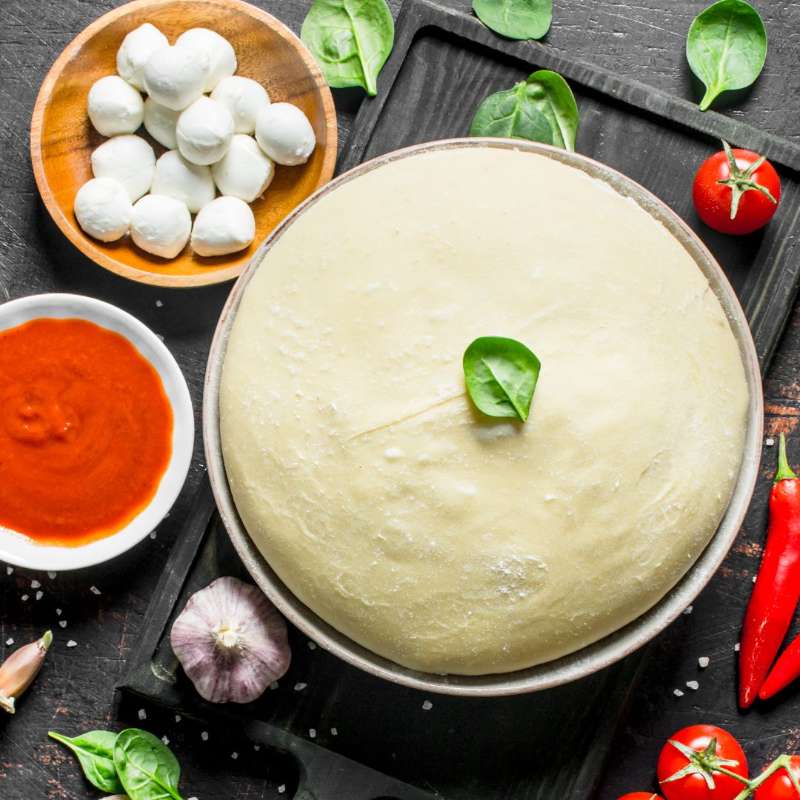Creating the perfect homemade pizza starts with a well-crafted dough, and understanding the role of each ingredient and its percentage in the recipe is key to achieving that delicious, crispy crust or soft and chewy base. In this guide, we'll explore the 10 essential ingredients for making homemade pizza dough and delve into the percentages that are typically used for each component.
We'll also look at the most common ingredients used as pizza toppings. Whether you're a seasoned pizza enthusiast or a beginner looking to master the art of pizza making, this comprehensive breakdown will help you craft the perfect dough for your next pizza night at home.

Using the best ingredients is crucial for enhancing your pizza's flavor and appearance. High-quality ingredients of pizza such as fresh mozzarella cheese, ripe tomatoes for sauce, and aromatic herbs like basil can elevate the taste profile of your homemade pizza recipe, providing a burst of freshness and depth of flavor with each bite.
Additionally, using premium ingredients can improve the overall appearance of your pizza, creating an appetizing visual appeal that entices the senses even before the first slice is taken. From vibrant colors to enticing aromas, choosing the best ingredients ensures that every aspect of your pizza, from taste to presentation, is of the highest caliber, guaranteeing a memorable dining experience for you and your guests.
Ingredients in Pizza
Here's a list of the 10 key ingredients for making homemade pizza dough and the 10 most popular toppings:
10 Common Pizza Dough Ingredients:
- All-purpose flour
- Yeast (active dry or instant)
- Warm water
- Olive oil
- Salt
- Sugar (optional, helps with yeast activation)
- Cornmeal (for dusting and adding texture)
- Herbs and spices (such as oregano, basil, garlic powder)
- Honey or agave syrup (for a touch of sweetness, optional)
- Whole wheat flour (for a healthier dough option)
10 Common Pizza Toppings:
- Mozzarella cheese (shredded or fresh)
- Tomato sauce or crushed tomatoes
- Pepperoni slices
- Sliced bell peppers (green, red, yellow)
- Sliced onions (red or yellow)
- Mushrooms (sliced)
- Cooked sausage (Italian sausage, chorizo, etc.)
- Fresh basil leaves
- Pineapple chunks (for Hawaiian pizza)
- Black olives (sliced)
These ingredients are versatile and can be mixed and matched to create a wide variety of delicious homemade pizzas.

Fresh Ingredients vs Store-Bought Ingredients
Using fresh ingredients versus store-bought ingredients in cooking, including making pizza, has its pros and cons from both convenience and nutritional perspectives.
Fresh Ingredients
Pros:
- Flavor: Fresh ingredients often have a superior flavor compared to their store-bought counterparts. For example, using freshly picked basil or tomatoes can impart a vibrant and authentic taste to your pizza.
- Nutritional Value: Fresh ingredients are typically higher in nutrients compared to processed or preserved ones. For instance, fresh vegetables and herbs contain more vitamins, minerals, and antioxidants.
- Customization: Using fresh ingredients allows you to customize your pizza toppings exactly as you like them. You can mix and match fresh vegetables, meats, and cheeses to create unique flavor combinations.
Cons:
- Availability: Fresh ingredients may not always be readily available, especially if you're looking for seasonal or locally sourced produce.
- Short Shelf Life: Fresh ingredients have a limited shelf life and may spoil quickly if not used promptly. This can lead to food waste if not planned and utilized effectively.
- Preparation Time: Using fresh ingredients often requires more preparation time, such as washing, chopping, and slicing, which can add to the overall cooking process.
Store-Bought Ingredients
Pros:
- Convenience: Store-bought ingredients are convenient and readily available at supermarkets and grocery stores, saving you time and effort in sourcing and preparing them.
- Longer Shelf Life: Store-bought ingredients, especially canned or preserved ones, have a longer shelf life compared to fresh ingredients, reducing the risk of spoilage and food waste.
- Consistency: Store-bought ingredients, such as pre-shredded cheese or canned tomato sauce, offer consistency in flavor and texture, ensuring a predictable outcome in your recipes.
Cons:
- Flavor and Nutritional Value: Some store-bought ingredients, particularly processed or pre-packaged ones, may lack the freshness and nutritional value of their fresh counterparts. For example, canned tomato sauce may contain added sugars or preservatives.
- Limited Customization: Store-bought ingredients may limit your ability to customize your pizza toppings exactly as you prefer. You may be constrained by the available options and may not achieve the same level of freshness and variety.
- Cost: In some cases, store-bought ingredients can be more expensive than buying fresh ingredients, especially if you opt for premium or specialty brands.
Both fresh and store-bought ingredients have their advantages and disadvantages. The choice between them often depends on factors such as availability, time constraints, budget, and personal preferences. For the best results, consider using a combination of fresh and store-bought ingredients to balance convenience, flavor, and nutritional value in your homemade pizzas.
Homemade Pizza Sauce Recipe
Creating your own homemade pizza sauce is not only easy but also allows you to customize the flavors to suit your taste preferences. This delicious sauce is the perfect complement to homemade pizza dough and fresh toppings, elevating your pizza-making experience to a whole new level.

With simple ingredients and a few minutes of preparation, you can enjoy a rich and flavorful pizza sauce that will make your homemade pizzas truly exceptional.
Ingredients:
- 1 can (28 ounces) crushed tomatoes
- 2 tablespoons tomato paste
- 2 cloves garlic, minced
- 1 teaspoon dried oregano
- 1 teaspoon dried basil
- 1/2 teaspoon dried thyme
- 1/2 teaspoon onion powder
- 1/4 teaspoon red pepper flakes (optional, for a spicy kick)
- Salt and black pepper to taste
- 1 tablespoon olive oil
- 1 teaspoon sugar (optional, to balance acidity)
Instructions:
- In a saucepan, heat olive oil over medium heat. Add minced garlic and sauté until fragrant, about 1 minute.
- Stir in crushed tomatoes, tomato paste, dried oregano, dried basil, dried thyme, onion powder, red pepper flakes (if using), salt, black pepper, and sugar (if using).
- Bring the sauce to a simmer, then reduce the heat to low and let it cook for about 15-20 minutes, stirring occasionally, until the sauce thickens to your desired consistency.
- Taste the sauce and adjust seasoning as needed, adding more salt, pepper, or sugar if desired.
- Remove the sauce from heat and let it cool slightly before using it as a base for your homemade pizzas.
This homemade pizza sauce can be stored in an airtight container in the refrigerator for up to a week or frozen for longer storage. Enjoy spreading this flavorful sauce on your freshly made pizza dough and topping it with your favorite ingredients for a delicious homemade pizza experience.
Homemade pizza dough recipe
Making your own pizza dough allows you complete control over the quality and flavor of your crust. By selecting high-quality ingredients and adjusting the ratios to suit your preferences, you can create a dough that perfectly complements your favorite toppings.

Additionally, the process of making pizza dough from scratch is a rewarding and enjoyable experience, providing a sense of accomplishment and connection to the food you create. Here's an easy recipe for making your own dough.
Ingredients:
-
1-1/2 cups warm water (about 110°F to 115°F)
-
1 teaspoon sugar
-
1/4 ounce active dry yeast - this is necessary for your dough to rise
-
3-1/2 cups Artisan "00" Pizza Flour
-
1/2 cup semolina flour or fine ground yellow cornmeal
-
1/3 cup olive oil Black Truffle Extra Virgin Olive Oil
-
1 teaspoon salt
Instructions:
-
Combine the yeast, water, and sugar in a mixing bowl and stir.
-
Let this combination sit until foamy on top.
-
Add 1/2 cup flour, the semolina flour, and 1/3 cup olive oil with the salt.
-
Mix and continue working in the flour a 1/4 cup at a time until completed.
-
Put the dough on a lightly floured work surface and knead until smooth and tacky.
-
Prepare a large mixing bowl coated with olive oil and place the dough in it.
-
Cover the bowl with wax paper or a wet towel.
-
Place in a warm area and let double in size; this usually takes more than an hour.
-
Knead the dough a little and separate into 2 equal portions.
-
At this point, use a large bowl with plastic wrap or store in an airtight bags; your dough is ready to use as directed in recipes with your favorite toppings.
Traditional Pizza Dough Percentages
In pizza dough recipes, ingredient percentages are often expressed in relation to the weight of the flour, which is considered 100%. This method, known as baker's percentage or baker's math, allows for easy scaling of recipes and ensures consistent results.

Here are the typical percentage ranges for each ingredient in pizza dough:
-
Flour (100%):
- The flour serves as the base ingredient and is always represented as 100% in baker's percentage. You can use all-purpose flour or a combination of all-purpose and whole wheat flour, adjusting hydration accordingly.
-
Yeast (0.5% to 2%):
- The yeast percentage varies based on the desired fermentation time and flavor development. A lower percentage (0.5% to 1%) is suitable for longer fermentation, resulting in a more complex flavor profile. A higher percentage (1.5% to 2%) is used for quicker rises and a milder taste.
-
Water (60% to 70%):
- The hydration level of the dough, expressed as a percentage of water relative to flour weight, affects dough texture. A higher hydration percentage (65% to 70%) results in a softer, more elastic dough, while a lower percentage (60% to 65%) yields a firmer dough.
-
Olive oil (1% to 5%):
- Olive oil adds richness to the dough and contributes to its texture and flavor. A lower percentage (1% to 2%) is sufficient for a subtle olive oil flavor, while a higher percentage (3% to 5%) creates a richer and softer dough.
-
Salt (1.5% to 2.5%):
- Salt enhances the flavor of the dough and regulates yeast activity. The percentage of salt is typically between 1.5% to 2.5%, with variations based on personal taste preferences.
-
Sugar (0% to 2%):
- Sugar is optional but can be added to the dough to provide a touch of sweetness and aid in yeast activation. The percentage of sugar ranges from 0% (for savory dough) to 2% (for slightly sweet dough).
-
Cornmeal (not included in baker's percentage):
- Cornmeal is used for dusting the pizza peel or baking surface and adds texture to the crust. It's not included in baker's percentage calculations for the dough.
-
Herbs and spices (small percentage relative to flour):
- Herbs like oregano and basil, along with spices like garlic powder, are added based on personal preference. These are typically used in small quantities relative to the flour, enhancing the flavor of the dough.
-
Honey or agave syrup (less than 1%):
- Honey or agave syrup can be added in small amounts (less than 1% of flour weight) to provide a subtle sweetness to the dough. This addition is optional and depends on the desired flavor profile.
-
Whole wheat flour (up to 50% of flour weight):
- Whole wheat flour can replace up to 50% of the all-purpose flour in the dough, adjusting hydration as needed to account for the higher absorption rate of whole wheat flour.
These percentages serve as guidelines and can be adjusted based on factors such as dough consistency, desired flavor, and baking conditions. Experienced bakers may adjust their favorite pizza recipes slightly based on factors like humidity, flour type, and desired dough characteristics.
The baker's percentage is a flexible guideline rather than a strict rule, allowing for customization and experimentation in pizza dough recipes. You'll also find that personal preference plays a key role in achieving the perfect pizza dough.
What are the 4 Main Components of Pizza?
The four main components of pizza are:
-
Dough: The base of the pizza, typically made from flour, active or instant yeast, water, salt, and sometimes olive oil. The dough is rolled out or stretched into a round shape to form the crust of the pizza.
-
Sauce: The sauce is spread over the pizza dough and serves as the base flavoring for the entire pizza. Traditional pizza sauce is made from crushed tomatoes, garlic, herbs (such as oregano and basil), and seasonings.
-
Cheese: Cheese is a key ingredient that adds richness and creaminess to the pizza. The most commonly used cheese on pizza is mozzarella, either fresh or shredded. Other cheeses like Parmesan, cheddar, provolone, or goat cheese can also be used.
-
Toppings: Toppings are the ingredients placed on top of the sauce and cheese to add flavor, texture, and variety to the pizza. Popular toppings include pepperoni, mushrooms, onions, bell peppers, olives, sausage, chili pepper, bacon, tomatoes, spinach, a drizzle of olive oil, and more. The choice of toppings is flexible and can be customized according to personal preferences.
What Ingredients are on a "Certified" Neapolitan pizza?
A traditional Neapolitan pizza, also known as Pizza Napoletana, follows specific guidelines and is made with a limited number of high-quality ingredients.
The ingredients on a Neapolitan pizza are as follows:
-
Dough: The dough for Neapolitan pizza is made from the best flour, usually Italian 00 flour, water, yeast, and salt. It's kneaded by hand and fermented for a minimum of 8 to 24 hours to develop flavor and texture.
-
Tomato Sauce: The sauce for Neapolitan pizza is made from San Marzano tomatoes, which are known for their sweetness and low acidity. The tomatoes are crushed or pureed and seasoned with a small amount of salt and sometimes a touch of olive oil.
-
Mozzarella Cheese: Neapolitan pizza traditionally uses fresh mozzarella cheese made from buffalo milk (mozzarella di bufala) or cow's milk (fior di latte). The cheese is sliced or torn into small pieces and scattered over the pizza.
-
Basil: Fresh basil leaves are a signature topping on Neapolitan pizza. The basil is added after the pizza comes out of the oven, allowing its aroma and flavor to infuse the hot pizza.
-
Olive Oil: A drizzle of extra virgin olive oil is often added to Neapolitan pizza before or after baking to enhance the flavors and add a hint of richness.
-
Salt: A sprinkle of sea salt may be added to the pizza before or after baking to balance the flavors and enhance the overall taste.
It's important to note that Neapolitan pizza follows strict guidelines set by the Associazione Verace Pizza Napoletana (AVPN) to ensure authenticity. These guidelines include using specific ingredients, such as Italian 00 flour, San Marzano tomatoes, fresh mozzarella, and fresh basil, as well as adhering to specific dough preparation and baking methods in a wood-fired oven at high temperatures.
Can you freeze homemade pizza dough?
Yes, you can freeze homemade pizza dough. Freezing pizza dough is a convenient way to prepare ahead of time and have dough ready for future pizza-making sessions. To freeze homemade pizza dough, follow these steps:
- Prepare the dough according to your favorite recipe and let it rise until it doubles in size.
- Punch down the dough to remove excess air and shape it into a ball.
- Lightly coat the ball of dough with olive oil to prevent it from sticking.
- Place the dough ball in a freezer-safe bag or container, making sure to remove as much air as possible before sealing.
- Label the bag or container with the date and type of dough (e.g., pizza dough) for easy identification.
- Place the dough in the freezer, where it can be stored for up to 3 months.
When you're ready to use the frozen pizza dough, remove it from the freezer and let it thaw in the refrigerator overnight. Once thawed, allow the dough to come to room temperature for about 30 minutes before shaping and baking your pizzas as usual.
Using an easy pizza dough recipe and then freezing your own pizza dough is a convenient way to have fresh dough on hand whenever you crave homemade pizza. Homemade pizza dough also allows for customization, whether you prefer a thin and crispy crust or a thicker, chewier one. Ultimately, making your own pizza dough ensures that each slice is not just a meal but a culinary journey tailored to your taste buds.
How long can dough stay frozen?
Homemade pizza dough can stay frozen for up to 3 months without significant loss of quality. It's important to properly store the dough in a freezer bag or container to prevent freezer burn and maintain its freshness. Labeling the dough with the date of freezing can help you keep track of its storage time and ensure that you use it within the recommended timeframe for the best results.






















